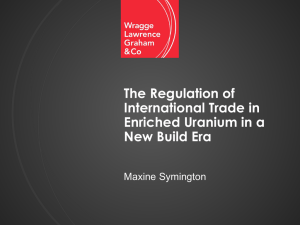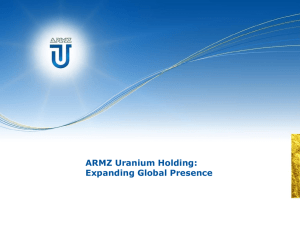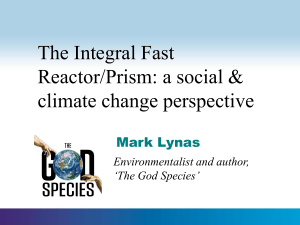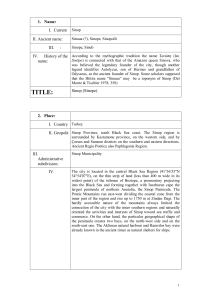conception of application of recycled uranium to increase
advertisement
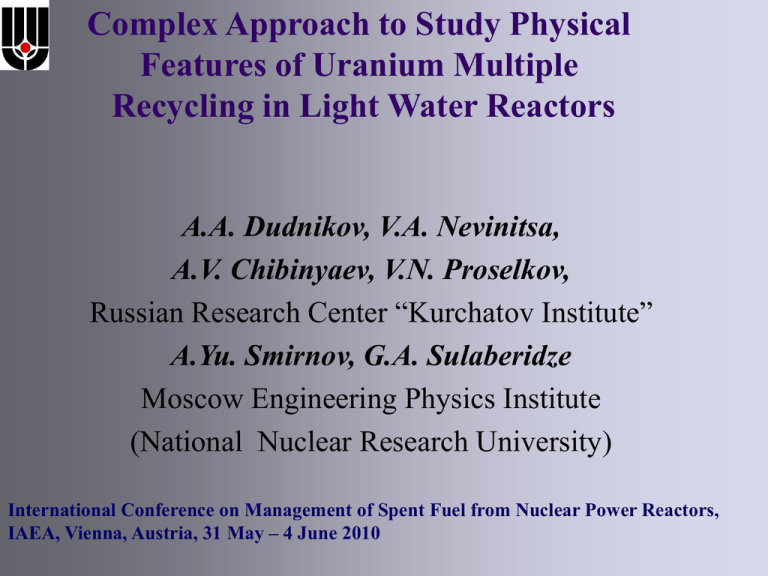
Complex Approach to Study Physical Features of Uranium Multiple Recycling in Light Water Reactors A.A. Dudnikov, V.A. Nevinitsa, A.V. Chibinyaev, V.N. Proselkov, Russian Research Center “Kurchatov Institute” A.Yu. Smirnov, G.A. Sulaberidze Moscow Engineering Physics Institute (National Nuclear Research University) International Conference on Management of Spent Fuel from Nuclear Power Reactors, IAEA, Vienna, Austria, 31 May – 4 June 2010 Introduction Irradiated uranium fuel contains more then 90% of uranium, but at the present time only small number of states has the experience in using of recycling uranium and this experience is limited to one recycle. At the same time multiple recycling decreases the need in uranium mining and improves the utilization of uranium resources. Calculations show that in VVER-1000 irradiated fuel residual U-235 concentration remains more than in natural uranium up to burnup level ~ 60 MW·days/kg of heavy metals (h.m.). 2 Fuel with Recycled Uranium (1/2) Utilization of reprocessed uranium as a source of fuel is more complicated due to U-232 and U-236 isotopes presenting in irradiated fuel. Some other uranium isotopes effect on the fuel reprocessing and fabrication is significantly less. U-236 is a parasitic neutron absorber and to compensate this effect fuel with recycled uranium must be enriched more than that free from U-236. The expression ∆C5 = K236·C6 is usually employed to determine the additional U-235 enrichment ∆C5 required compensate for the reactivity penalty due to U-236 concentration C6. Reactivity compensation factor K6 can be defined from the requirement to keep the same fuel campaign for reprocessed fuel. 3 Fuel with Recycled Uranium (2/2) Analysis of calculations shows that for the VVER-1000 fuel with recycled uranium compensation factor K236 = 0.3+0.05 can be recommended U-232 effect on neutron physical parameters is negligible due to very small concentration in reprocessed uranium. However introduction of this isotope may lead to an increase radiation dose rate to personnel because of the hard gamma rays from its decay daughters. To limit this dose rate at the fuel fabrication plant U-232 concentration in fuel with recycled uranium was restricted at the level 2·10-7 wt. %. Taking into account the enhanced technologies of fuel pin fabrication this restriction can become softer. 4 Multi-Recycled Modeling (1/4) In present paper the combined approach was implemented on the base of simultaneous modeling of neutron-physical processes and processes of cascade isotope separation for analysis of physical problems of usage multirecycled uranium for LWR fuel cycle. The goal of the investigation was evaluation of relative consumption of natural uranium for additional uranium enrichment depending on U-232 concentration in recycled uranium. The parasitic neutron absorption in U-236 was compensated by additional U-235 enrichment. 5 Multi-Recycled Modeling (2/4) 1. 2. An initial loading is supposed enriched and fabricated from natural uranium only. Fresh fuel isotope composition obtained after gas centrifuges enrichment was calculated in following assumptions: ideal cascade was implemented without mixing on relative concentrations of 235UF6 and 238UF6; stage separation factor was equal to 1.2 . Then fuel is irradiated in reactor of VVER-1000 type up to given burnup level and after during 10 years is cooled and reprocessed. Uranium is separated and turns to fresh fuel fabrication. 6 Multi-Recycled Modeling (3/4) Equivalent mass concentration of U-235 in the enrichment product stream is obtained from equation P P P C235 C К C eq 235nat 236 236 Then new fresh fuel is irradiated, cooled, reprocessed and enriched as it is described above Heterogeneous model of pin fuel cell was used for neutron-physical calculations to obtain neutron induced reaction rates. Calculations were performed with the MCNP5 Monte Carlo code. 7 Multi-Recycled Modeling (4/4) For re-enrichment purpose quasi-ideal cascade is implemented containing natural uranium feed (F) and additional reprocessed uranium feed (E) . The scheme of the separating cascade with an additional flow of a feed 8 Scenario of Uranium Multiple Recycling Cycle 1 Low Enriched Uranium Natural Uranium Cascade Enrichment of Natural Uranium Cascade Enrichment Natural Uranium Recycled Uranium Recycled Uranium Cascade Enrichment Irradiation Spent Fuel Cooling and Reprocessing Recycled Uranium Cycle 2 Cycle 2 Low Enriched Uranium Irradiation Spent Fuel Cooling and Reprocessing Recycled Uranium Spent Fuel Cooling and Reprocessing Recycled Uranium Cycle3....Cycle N Cycle N Low Enriched Uranium Irradiation 9 Scenario of Uranium Multiple Recycling The following set of uranium recycling scenarios is considered: With restrictions on U-232 in product flow, =2∙10-7%. With restrictions on U-232 in product flow, =5·10-7%. Without restrictions on U-232. Two burnup levels were considered: 48 MW·days/kg (h.m.) and 60 MW·days/kg (h.m.) 10 Natural uranium relative consumption, recycled uranium relative consumption and relative separation work consumption in dependence on recycle number. Initial enrichment is 4.0% wt, burnup is 48 MW days/kg (h.m) 11 Natural uranium relative consumption, recycled uranium relative consumption and relative separation work consumption in dependence on recycle number. Initial enrichment is 4.4% wt, burnup is 60 MW days/kg (h.m) 12 Specific natural uranium consumption and separation work for five consecutive recycles, with and without account of U-236 compensation Recycle number, 48 MW days/kg Specific natural uranium consumption Specific excess consumption of natural uranium for U-236 compensation, % With U-236 compensation Without U-236 compensation 1 5.343 5.157 3.52 2 5.373 5.075 5.55 3 5.370 4.986 7.15 4 5.379 4.934 8.29 5 5.393 4.904 9.08 13 Specific natural uranium consumption and separation work for five consecutive recycles, with and without account of U-236 compensation Recycle number, 60 MW days/kg Specific natural uranium consumption Specific excess consumption of natural uranium for U-236 compensation, % With U-236 compensation Without U-236 compensation 1 6.273 6.076 3.14 2 6.308 6.005 4.81 3 6.306 5.923 6.07 4 6.312 5.876 6.91 5 6.327 5.856 7.44 14 Problem of U-236 Besides the fact that the presence of U-236 in fuel makes additional fuel enrichment necessary in order to reduce the parasitic neutron absorption, this isotope is also one of the factors causing the growth of U-232 concentrations in spent fuel during the next recycles. This is due to the fact that in reactor irradiation conditions this isotope (via the short-lived U-237) is the precursor of Np-237, which, in its turn, precedes U-232 through the chain of radioactive transformations Np-237 (n,2n) Np-236m 0.48(-) Pu-236 () U-232. 15 U-232 concentration during irradiation in VVER-1000 fuel cell, with and without account of Np-237 (n,2n) Np-236m reaction 16 Fragment of chains of nuclear reactions at an irradiation of fuel in a core 17 There is a tendency to growth of mass concentrations of U-232 and Np-237 in spent fuel with growth of recycle number in case of absence of restriction on U-232 in fresh fuel. These factors result to problems with recycled uranium usage because of increase of hard gamma rays emitters concentration. 18 Implementation of restriction on U-232 concentration in fresh fuel, made from recycled uranium, due to dilution of U-236 in fresh fuel, allows to moderate growth of U-232 concentration in spent fuel and makes it possible to reach equilibrium of U-232 and Np-237 concentrations in spent fuel 19 U-232 and U-236 Concentration in Fuel Recycling in Dependence of Recycle Number (48 MW Days/kg) The existence of isotope correlation between U-232 and Np-237 is the reason of the existence of isotope correlation between U-232 and U-236 in fresh and spent fuel. 20 CONCLUSIONS Analysis of calculated results allows the following conclusions to be formulated in connection with the scenarios considered Multiple usage of recycled uranium without any limitations imposed on the content of U-232 isotope allows natural uranium consumption to be reduced by about 16% and 10% for the respective burnup rates of 48 and 60 MWday/kg. In case the content of U-232 is limited (by 2∙10-7 mass %), natural uranium economy reduces to 7% and 3.5% for the respective burnup rates of 48 and 60 MWday/kg. Identified conditions of achieving equilibrium concentrations of U-232 show that this would require the contents of U-236 in fresh fuel to be limited (in the given study this limitation occurred naturally as a result of recycled uranium dilution to admissible U-232 concentrations). Excess amounts of natural uranium spent on U-236 compensation, depending on the specific recycle number, lie between 3.5 and 9% for the burnup of 48 MWday/kg, and between 3 and 7% for the burnup of 60 MWday/kg Results of this study lead to the conclusion that development of U-236 separation technology could reduce accumulation of U-232 in the LWR fuel cycle and improve natural uranium economy. 21



